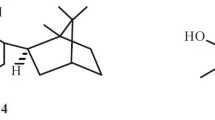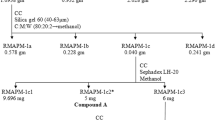Abstract
Hydroxycinnamic acids have a variety of biological activities, including antioxidant activity. To find more active antioxidants with hydroxycinnamoyl moiety, we synthesized a series of N-hydroxycinnamoyl amino acid esters and evaluated their antioxidative activities by 2,2-diphenyl-1-picryl hydrazyl (DPPH) radical scavenging and human red blood cells (RBCs) haemolysis methods. It was found that N-caffeoyl amides exhibited the highest DPPH-scavenging activities, whereas N-feruloyl amides demonstrated the highest antihaemolysis activities among the three different hydroxycinnamamides (caffeoyl, feruloyl, and p-coumaroyl), and that hydroxycinnamoyl amides were more effective than their corresponding free acid and ester compounds in both DPPH and RBC haemolysis tests.



Similar content being viewed by others
References
Anderson RF, Fisher LJ, Hara Y, Harris T, Mak B, Melton LD, Packer JE (2001) Green tea catechins partially protect DNA from •OH radical-induced strand breaks and base damage through fast chemical repair of DNA radicals. Carcinogenesis 22:1189–1193
Anselmi C, Centini M, Andreassi M, Buonocore A, Rosa CL, Facino RM, Sega A, Tsuno F (2004) Conformational analysis: a tool for the elucidation of the antioxidant properties of ferulic acid derivatives in membrane models. J Pharm Biomed Anal 35:1241–1249
Charvat T, Lee DJ, Robinson WE (2006) Design, synthesis, and biological evaluation of chicoric acid analogs as inhibitors of HIV-1 integrase. Bioorg Med Chem 14:4552–4567
Cheng JC, Fang JG, Chen WF, Zhou B, Yang L, Liu ZL (2006) Structure–activity relationship studies of resveratrol and its analogues by the reaction kinetics of low density lipoprotein peroxidation. Bioorg Chem 34:142–157
Foti M, Ruberto G (2001) Kinetic solvent effects on phenolic antioxidant determined by spectrophotometric measurements. J Agric Food Chem 49:342–348
Goupy P, Dufour C, Loonis M, Dangles O (2003) Quantitative kinetic analysis of hydrogen transfer reactions from dietary polyphenols to the DPPH radical. J Agric Food Chem 51:615–622
Kang SS, Kim HJ, ** C, Lee YS (2009) Synthesis of tyrosinase inhibitory (4-oxo-4H-pyran-2-yl)acrylic acidester derivatives. Bioorg Med Chem Lett 19:188–191
Lai YY, Huang LJ, Lin HC, Wu TS, Teng CM, Kuo SC (2002) Synthesis and anti-platelet activity of ferulamide derivatives. Chin Pharm J 54:41–52
Lass A, Sohal RS (1998) Electron transport-linked ubiquinone-dependent recycling of a-tocopherol inhibits autooxidation of mitochondrial membranes. Arch Biochem Biophys 352:229–236
Lee S, Lee CH, Oh JH, Kim EE, Choi YK, Kim EH, Lee WS, Bok SH, Jeong TS (2003) Anti-atherogenic effects of 3, 4-dihydroxy hydrocinnamides. Bioorg Med Chem Lett 13:2681–2682
Lee S, Han JM, Kim H, Kim E, Jeong TS, Lee WS, Cho KH (2004) Synthesis of cinnamic acid derivatives and their inhibitory effects on LDL-oxidation, acyl-CoA: cholesterol acyltransferase-1 and -2 activity, and decrease of HDL-particle size. Bioorg Med Chem Lett 14:4677–4681
Lucarini M, Mugnaini V, Pedulli GF (2002) Bond dissociation enthalpies of polyphenols: the importance of cooperative effects. J Org Chem 67:928–931
Narasimhan B, Belsare D, Pharande D, Mourya V, Dhake A (2004) Esters, amides and substituted derivatives of cinnamic acid: synthesis, antimicrobial activity and QSAR investigations. Eur J Med Chem 39:827–834
Niki E (1990) Free radical initiators as source of water- or lipid-soluble peroxyl radicals. Methods Enzymol 186:100–108
Orlandi M, Rindone B, Molteni G, Rummakko P, Brunow G (2001) Asymmetric biomimetic oxidations of phenols: the mechanism of the diastereo- and enantioselective synthesis of dehydrodiconiferyl ferulate (DDF) and dehydrodiconiferyl alcohol (DDA). Tetrahedron 57:371–378
Rice-Evans CA, Miller NJ, Paganga G (1996) Structure antioxidant activity relationships of flavonoids and phenolic acids. Free Radical Biol Med 20:933–956
Robbins RJ (2003) Phenolic acids in foods: an overview of analytical methodology. J Agric Food Chem 51:2866–2887
Scalbert A, Williamson G (2000) Dietary intake and bioavailability of polyphenols. J Nutr 130:2073S–2085S
Tanguy JM (1985) The occurrence and possible function of hydroxycinnamoyl acid amides in plants. Plant Growth Regul 3:381–399
Tanguy JM, Cabanne F, Pedrizet E, Martin C (1978) The distribution of hydroxycinnamic acid amides in flowering plants. Phytochemistry 17:1927–1928
Tebayashi S, Ishihara A, Tsuda M, Iwamura H (2000) Induction of clovamide by jasmonic acid in red clover. Phytochemistry 54:387–392
Tsuda H, Ohshima Y, Nomoto H, Fujita K, Matsuda E, Iigo M, Takasuka N, Moore MA (2004) Cancer prevention by natural compounds. Drug Metab Pharmacokin 19:245–263
Wei QY, Chen WF, Zhou B, Yang L, Liu ZL (2006a) Inhibition of lipid peroxidation and protein oxidation in rat liver mitochondria by curcumin and its analogues. Biochim Biophys Acta 1760:70–77
Wei QY, Zhou B, Cai YJ, Yang L, Liu ZL (2006b) Synergistic effect of green tea polyphenols with trolox on free radical-induced oxidative DNA damage. Food Chem 96:90–95
Wright JS, Johnson ER, Dilabio GA (2001) Predicting the activity of phenolic antioxidants: theoretical method, analysis of substituent effects, and application to major families of antioxidant. J Am Chem Soc 123:1173–1183
Yoya GK, Belval FB, Constant P, Duran H, Daffe M, Baltas M (2009) Synthesis and evaluation of a novel series of pseudo-cinnamic derivatives as antituberculosis agents. Bioorg Med Chem Lett 19:341–343
Zhou B, Miao Q, Yang L, Liu ZL (2005) Antioxidative effects of flavonols and their glycosides against the free-radical-induced peroxidation of linoleic acid in solution and in micelles. Chem Eur J 11:680–691
Acknowledgments
This work was supported by the National Natural Science Foundation of China (Grant NO. 20702016).
Author information
Authors and Affiliations
Corresponding author
Rights and permissions
About this article
Cite this article
Wei, QY., Jiang, H., Zhang, JX. et al. Synthesis of N-hydroxycinnamoyl amino acid ester analogues and their free radical scavenging and antioxidative activities. Med Chem Res 21, 1905–1911 (2012). https://doi.org/10.1007/s00044-011-9713-2
Received:
Accepted:
Published:
Issue Date:
DOI: https://doi.org/10.1007/s00044-011-9713-2




